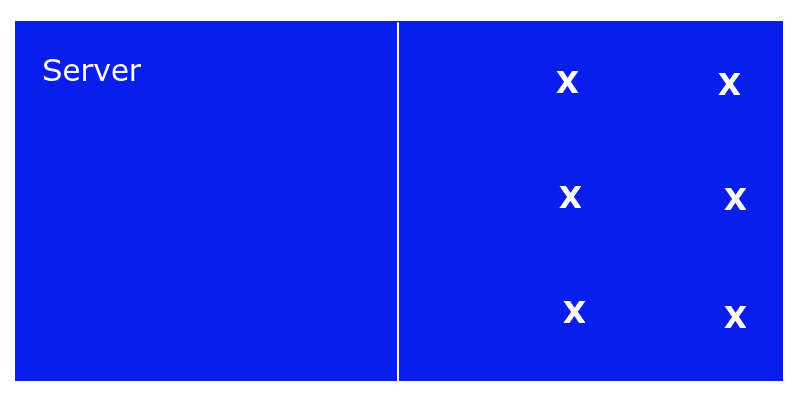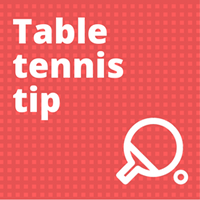What is the best table tennis serve you can do? A serve which is guaranteed to win you a point against any opponent. A serve which is unreadable. A serve which is unreturnable.
I’m going to disappoint you.
There is no single unreadable and unreturnable table tennis serve, which will beat all opponents. Every serve is returnable if you know how.
But, it is possible to execute the perfect table tennis serve, against the right opponent at the right time in a match.
Let me explain what I mean.
Think of a serve you do. Your favourite serve. Now look at the diagram below.

The table has 6 positions where you can place your serve. 3 long and 3 short. How many of the positions marked with an ‘X’ can you serve to? 1 position? 2 positions? 3 positions?
Actually, you should learn to serve your favourite serve to all six positions.
Why?
It’s rare that an opponent will be able to return the ball equally as strongly from each position. Your opponent may be able to return your favourite serve brilliantly if it is aimed long at his backhand. But the same opponent may struggle with the same serve if it is served short to his forehand. Even if you face a much stronger opponent, there will usually be a position on the table where he is weaker.
Your job is to find out where that weak position is.
How do you do this?
There are two main ways.
1 – Observation. When you’re at a tournament or a league match and waiting to play, don’t sit idly staring into space or mess around with your phone. Use the opportunity to observe your opponents. Try to identify which types of serve they struggle with and where the serves are placed. This will give you a head start before your match has even begun.
2. Trial and error. When you play an opponent for the first time, you need to try out your serve to different positions. You need to quickly establish his strong areas and weak areas. The first game of the match is an ideal time to do this. If you can work out early your opponent’s weak area(s), you have the rest of the match to exploit it. If you don’t start testing different areas until you’re behind and close to defeat, it will most likely be too late. The more you play the same opponent, the more you will build up a knowledge of the best positions you should serve to and less trial and error will be needed.
What is a weak return?
Your main goal with targeting your opponent’s weak area, is to get a weak return of serve. This does not necessarily mean a miss (although this is a bonus). A weak return also means a loose ball – something which is returned a little high and is easy to attack.
A weak return can even mean a decent return but also a predictable return. If the return of serve is predictable, it is much easier to prepare for and execute a third ball attack, as you know what is coming.
Using your serve strategically
When you have identified your opponent’s weak position, you need to think about using your serve strategically.
You probably should avoid using the same serve to the same position all the time, as your opponent may start getting used to it.
But you don’t want to use the serve too infrequently either. You need to take advantage of the weakness.
So think about using the serve at significant points in the match. These are:
At the beginning of a game. It’s great to build an early lead. You put our opponent under pressure straight away and, if like me, you play better when you have a lead.
In the middle of the game. If I’m behind (6-4), two good serves can get me level with my opponent. If tied, (6-6), two good serves can nudge me in the lead and put me within touching distance of a game point. If I’m in the lead (6-4), it can help me build a significant points lead.
At the end of a close game. This is when your favourite serve aimed at your opponent’s weak point can be most effective. When a player has game point or is facing a game point in a close game (i.e. the score is 10-9), he will often play a little more cautiously. He may well return your serve even weaker than before. This is a great opportunity for you either save a game point (if 9-10) or win the game (if 10-9).
The perfect serve
So this is what I mean by the perfect serve. You use the right serve, in the right position, at the right time in a match, against the right opponent. And you win the point. Perfect.
And the good news?
You already have the perfect table tennis serve in your game. You don’t need to learn a new wonder serve. Just take your favourite serve and learn to serve it to different positions.
When you can serve it to different positions, you can then test out which area is most effective against each opponent.
When you have found an opponent’s weak area, you can exploit it for lots of easy points.
Want more service tips?
If you want more service tips, I recommend you join Tom’s TT Academy. You will also get access to a wide range of coaching content, including:
- in-depth courses
- training drills
- session plans
- video analysis
- fitness videos
- robot training videos
- member discussions
- skill challenges
- and lot’s more!
You can access all this content for less than £1 per week. New content is added regularly. Join hundreds of table tennis players around the world today at tomsttacademy.com

